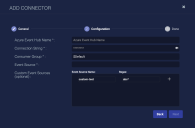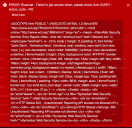Configuring Azure Event Hub Connectors
Azure Event Hub connectors allow Stellar Cyber to ingest Azure events and add them to the data lake.
Connector Overview: Azure Event Hub
Capabilities
-
Collect: Yes
-
Respond: No
-
Native Alerts Mapped: No
-
Runs on: DP
-
Interval: Continuous
Collected Data
|
Content Type |
Index |
Locating Records |
|---|---|---|
|
Azure Activity Log Azure Bastion Azure Firewall Azure Keyvault Azure Security Center Azure Security Groups Azure SQL Server Azure Storage Azure Synapse Workspace Azure Web Application Firewall |
Syslog |
Domain
N/A
Response Actions
N/A
Third Party Native Alert Integration Details
N/A
Required Credentials
-
Eventhub Name, Connection String, Consumer Group
Let us know if you find the above overview useful.
Adding an Azure Event Hub Connector
To add an Azure Event Hub connector:
- Gather the Event Hub information
- Add the connector in Stellar Cyber
- Test the connector
- Verify ingestion
Gathering the Event Hub Information
Gather the following Event Hub information.
The subscription plan needed for the Azure Event Hub connector is Basic.
-
Eventhub Name: The name of the Event Hub
-
Connection String: Find the connection string in Azure. You must use a unique connection string for each of your Stellar Cyber Azure Event Hub connector instances.
-
Consumer Group: The consumer group for the Event Hub
-
Event Source: The source of the events you want to ingest (you must configure these sources to send data to your Event Hub):
-
AzureActivityLog
-
AzureBastion

-
AzureFirewall
-
AzureKeyVault

-
AzureSecurityCenter
-
AzureSecurityGroups

-
AzureSQLServer (includes AuditEvent log )
-
AzureStorage
-
AzureSynapseWorkspace
-
AzureWebApplicationFirewall
-
Adding the Connector in Stellar Cyber
With the access information handy, you can add an Azure Event Hub connector in Stellar Cyber:
-
Log in to Stellar Cyber.
-
Click System | Integration | Connectors. The Connector Overview appears.
-
Click Create. The General tab of the Add Connector screen appears. The information on this tab cannot be changed after you add the connector.
The asterisk (*) indicates a required field.
-
Choose PaaS from the Category drop-down.

-
Choose Azure Event Hub from the Type drop-down.
-
For this connector, the supported Function is Collect, which is enabled already.
-
Enter a Name.
This field does not accept multibyte characters.
-
Choose a Tenant Name. The Interflow records created by this connector include this tenant name.
-
Choose the device on which to run the connector.
-
(Optional) When the Function is Collect, you can create Log Filters. For information, see Managing Log Filters.

-
Click Next. The Configuration tab appears.
The asterisk (*) indicates a required field.
-
Enter the Azure Eventhub Name you copied earlier.
-
Enter the Connection String you copied earlier.
-
Enter the Consumer Group you copied earlier.
-
Select one or more Event Sources. The currently available sources are:
-
Azure Activity Log
-
Azure Bastion

-
Azure Firewall
-
Azure KeyVault

-
Azure Security Center
-
Azure Security Groups

-
Azure SQL Server (includes AuditEvent log
 )
) -
Azure Storage
-
Azure Synapse Workspace
-
Azure Web Application Firewall
The order of the event sources in the above list dictates the content type that will be matched first. The event source that was added first will match first.
-
Custom Event Source (choose only if using optional Custom Event Sources)

-
-
(Optional) Use Custom Event Sources to set up customized event sources that pull specific types of data from Azure Event Hub.

-
Enter a name for the Event Source Name that is unique within the connector. The name will be used for setting the
msg_classin the following format:azure_<customer defined name delimited with underscores>. -
Enter a Regex, a Regular Expression that defines a unique string expected in the data, for example,
abc*. The connector looks in Azure Event Hub and pulls any data that matches the Regex. -
Click the + sign to add another custom event source. The recommended maximum is 10.
The order of the event sources in the list dictates the content type that will be matched first. The custom event source that appears in the list at the top will match first, meaning that the one added last will match first.
-
Click the trash can to delete a custom event source.
-
-
Click Next. The final confirmation tab appears.
-
Click Submit.
To pull data, a connector must be added to a Data Analyzer profile if it is running on the Data Processor.
The new connector is immediately active.
Testing the Connector
When you add (or edit) a connector, we recommend that you run a test to validate the connectivity parameters you entered. (The test validates only the authentication / connectivity; it does not validate data flow).
For connectors running on a sensor, Stellar Cyber recommends that you allow 30-60 seconds for new or modified configuration details to be propagated to the sensor before performing a test.
-
Click System | Integrations | Connectors. The Connector Overview appears.
-
Locate the connector that you added, or modified, or that you want to test.
-
Click Test at the right side of that row. The test runs immediately.
Note that you may run only one test at a time.
Stellar Cyber conducts a basic connectivity test for the connector and reports a success or failure result. A successful test indicates that you entered all of the connector information correctly.
To aid troubleshooting your connector, the dialog remains open until you explicitly close it by using the X button. If the test fails, you can select the button from the same row to review and correct issues.
The connector status is updated every five (5) minutes. A successful test clears the connector status, but if issues persist, the status reverts to failed after a minute.
Repeat the test as needed.
Verifying Ingestion
To verify ingestion:
- Click Investigate | Threat Hunting. The Interflow Search tab appears.
- Change the Indices to Syslog. The table immediately updates to show ingested Interflow records.
For custom event sources, the unique name provided during configuration displays in Threat Hunting with a
msg_classcontaining anazureprefix. For example, if the unique name istest, themsg_classin Threat Hunting isazure_test.








